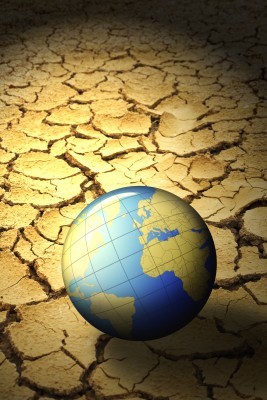 |
(123rf) |
Tens of millions of people may be spared droughts and floods by 2050 if Earth-warming carbon emissions peak in 2016 rather than 2030, scientists said on Sunday.
Climate researchers in Britain and Germany said emission cuts now would delay some crippling impacts by decades and prevent some altogether.
By 2050, an Earth heading for warming of 2-2.5 degrees Celsius (3.6-4.5 degrees Fahrenheit) by 2100 could have two very different faces, depending on the route taken to get there, said their study published in the journal Nature Climate Change
Policies that cap Earth-warming carbon emissions in 2016 and then reduce them by five percent per year could see between 39 and 68 million people spared exposure to a higher risk of water shortages by 2050, Nigel Arnell of the University of Reading told AFP.
This is the best-case scenario, though.
In contrast, if emissions peak in 2030 and fall by five percent annually, the number who escape this risk drops to between 17 and 48 million.
Similarly, about 100-161 million people would avoid a higher risk of river flooding on the 2016-peak scenario.
This compares to 52-120 million people if emissions peak 14 years later, said Arnell, director of the university‘s Walker Institute on climate change.
“Basically in 2050, the 2030-peaking policy has about half to two-thirds of the benefit than the best (2016) policy,” even though both lead to a similar temperature peak of about 2-2.5 deg C by 2100, he said.
“You may hit the same (temperature) point at the end of the century but... the mayhem that’s been caused on the way to that point is different under the different pathways.”
Under a scenario without any emissions curbs, temperatures could rise as much as 4-5.5 deg C, said the new paper which claimed to be the broadest assessment yet of the benefits of avoiding climate change impacts.
Global average warming of 4 deg C would see almost a billion people have less water in 2100 than they have now, and 330 million will be at greater risk of river flooding, Arnell told a pre-release press conference.
A peak in 2016 seems unlikely, with the world‘s nations aiming to adopt a new global climate pact by 2015 for entry into force only five years later.
The latest round of UN climate talks that concluded in Doha, Qatar in December failed to set pre-2020 emissions cuts for countries that have not signed up to the Kyoto Protocol that seeks to curb warming, even as scientists warned the concentration of carbon in the atmosphere continues to rise.
Three of the world’s four biggest polluters -- China, the United States and India -- are among those with no binding emission limits, which cover countries responsible for only about 15 percent of the world‘s carbon pollution.
Many scientists believe that Earth is set for warming that will be far above the United Nations’ 2 deg C target on pre-industrial levels.
“Reducing greenhouse gas emissions won‘t avoid the impacts of climate change altogether of course, but our research shows it will buy time to make things like buildings, transport systems and agriculture more resilient to climate change,” said Arnell. (AFP)
<관련 한글 기사>
기온상승 2도만 낮춰도 기후피해 크지 않아
이산화탄소 배출량이 2030년이 아닌 2016년에 최고점을 찍는다면 몇 백만 명의 사람들이 가뭄과 홍수의 피해를 입지 않을 것이라는 연구결과가 나왔다.
2016년부터 이산화탄소 배출량을 규제하고 그 후로 매년 5퍼센트씩 배출량을 줄여나가면 약 3천9백만명에서 6천8백만명의 사람들이 2050년까지 물 부족 현상과 홍수을 겪지 않을 것이라고 레딩대학 나이절 아넬 소장이 언급했다.
반대로, 이산화탄소 배출량이 2030년에 최고점을 찍고 그 후로 매년 5퍼센트씩 줄어든다면 물 부족 현상을 겪지 않을 인구수는 1천7백만명에서 4천8백만명 사이로 줄어들 것이다.
탄소배출량 규제를 하지 않는다면 지구온도는 약 4도에서 5.5도까지 오를 것이라고 아넬 소장은 언급했다. 이러한 온도에서는 2100년 물부족 현상을 겪는 인구는 10억 가까이 될 것이며 홍수피해를 입을 인구도 3억3천만명이 넘을 것으로 예상된다.
거듭되는 탄소배출량에 대한 과학계의 우려에도 불구, 지난해 12월 카타르 도하에서 열린 유엔 기후변화협약 당사국 총회는 교토의정서에 참여하지 않은 국가의 탄소규제 시행에 실패한 바 있다. 탄소 최다 배출 국가인 중국, 미국과 인도는 탄소규제 제약을 받지 않는다.
“온실가스 배출량을 감소시키는 것만으로 기후변화의 악영향을 모두 피하는 것은 당연히 어려운 일입니다. 하지만 기후변화에 유연한 건물, 교통 시스템과 농업을 개발하는 것은 기후변화를 맞이하기 전 시간을 벌어줄 수 있다는 연구결과가 나왔습니다” 라고 아넬 소장은 밝혔다. (코리아헤럴드)



![[Herald Interview] 'Korea, don't repeat Hong Kong's mistakes on foreign caregivers'](http://res.heraldm.com/phpwas/restmb_idxmake.php?idx=644&simg=/content/image/2024/11/13/20241113050481_0.jpg)
![[KH Explains] Why Yoon golfing is so controversial](http://res.heraldm.com/phpwas/restmb_idxmake.php?idx=644&simg=/content/image/2024/11/13/20241113050608_0.jpg)



